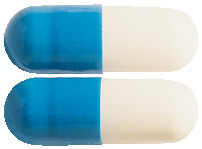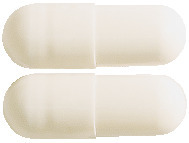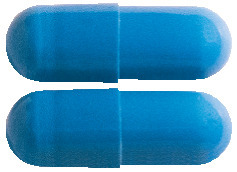SUMMARY CMI
VOQUILY
Consumer Medicine Information (CMI) summary
The full CMI on the next page has more details. If you are worried about using this medicine, speak to your doctor or pharmacist.
▼ This medicine is new or being used differently. Please report side effects. See the full CMI for further details.
1. Why am I using VOQUILY?
VOQUILY contains the active ingredient melatonin. VOQUILY is used to treat adults with jet lag and sleep disorders in children with neurodevelopmental disorders.
For more information, see Section 1. Why am I using VOQUILY? in the full CMI.
2. What should I know before I use VOQUILY?
Do not use if you have ever had an allergic reaction to VOQUILY or any of the ingredients listed at the end of the CMI.
Talk to your doctor if you have any other medical conditions, take any other medicines, or are pregnant or plan to become pregnant or are breastfeeding.
For more information, see Section 2. What should I know before I use VOQUILY? in the full CMI.
3. What if I am taking other medicines?
Some medicines may interfere with VOQUILY and affect how it works.
A list of these medicines is in Section 3. What if I am taking other medicines? in the full CMI.
4. How do I use VOQUILY?
- The standard starting dose is 2 mg once daily, before bed or preferred sleep time. In some cases, your doctor may increase your dose.
- VOQUILY should be taken on an empty stomach.
More instructions can be found in Section 4. How do I use VOQUILY? in the full CMI.
5. What should I know while using VOQUILY?
| Things you should do |
|
| Things you should not do |
|
| Driving or using machines |
|
| Looking after your medicine |
|
For more information, see Section 5. What should I know while using VOQUILY? in the full CMI.
6. Are there any side effects?
The most common side effects are sleepiness, headache, dizziness, nausea, stomach cramps and hyperactivity. Tell your doctor or pharmacist immediately, if you notice any of the following side effects: signs of an allergic reaction, seizures, tightness in chest, fast or irregular heartbeat, suicide attempt or suicidal thoughts.
For more information, including what to do if you have any side effects, see Section 6. Are there any side effects? in the full CMI.
▼ This medicine is subject to additional monitoring. This will allow quick identification of new safety information. You can help by reporting any side effects you may get. You can report side effects to your doctor, or directly at www.tga.gov.au/reporting-problems.
FULL CMI
VOQUILY
Active ingredient(s): melatonin
Consumer Medicine Information (CMI)
This leaflet provides important information about using VOQUILY. You should also speak to your doctor or pharmacist if you would like further information or if you have any concerns or questions about using VOQUILY.
Where to find information in this leaflet:
1. Why am I using VOQUILY?
2. What should I know before I use VOQUILY?
3. What if I am taking other medicines?
4. How do I use VOQUILY?
5. What should I know while using VOQUILY?
6. Are there any side effects?
7. Product details
1. Why am I using VOQUILY?
VOQUILY contains the active ingredient melatonin. Melatonin is naturally occurring hormone produced in the body. It is one of the main hormones that helps you to sleep.
VOQUILY is used for the treatment of a number of conditions.
- Jet lag in adults 18 years and older.
- Sleep Disorders in children and adolescents aged 6 to 18 years with neurodevelopmental disorders including autism spectrum disorder (ASD) and attention deficit hyperactivity disorder (ADHD)
2. What should I know before I use VOQUILY?
Warnings
Do not use VOQUILY if:
- you are allergic to melatonin, or any of the ingredients listed at the end of this leaflet.
Always check the ingredients to make sure you can use this medicine.
Check with your doctor if you:
- have or had the following medical conditions:
- an autoimmune disease
- a seizure disorder such as epilepsy
- problems with your liver
- problems with your kidneys - take any medicines for any other condition.
During treatment, you may be at risk of developing certain side effects. It is important you understand these risks and how to monitor for them. See additional information under Section 6. Are there any side effects?
Pregnancy and breastfeeding
Check with your doctor if you are pregnant or intend to become pregnant.
Melatonin is not recommended if you or your child are pregnant. Melatonin crosses the placenta and there is insufficient information on the risk this may pose to the unborn child.
Talk to your doctor if you are breastfeeding or intend to breastfeed.
Melatonin is not recommended if you or your child are breastfeeding. Melatonin passes into human milk, and the risk to the breast-fed child cannot be excluded.
3. What if I am taking other medicines?
Tell your doctor or pharmacist if you are taking any other medicines, including any medicines, vitamins or supplements that you buy without a prescription from your pharmacy, supermarket or health food shop.
Some medicines may interfere with VOQUILY and affect how it works.
These include:
- hypnotics (such as benzodiazepines, zolpidem and zopiclone)
- fluvoxamine, thioridazine and imipramine (used to treat depression or psychiatric conditions)
- oestrogens (contraceptives or hormone replacement therapies)
- cimetidine (used to treat reflux and stomach ulcers)
- psoralens (used to treat skin conditions such as psoriasis)
- antibiotics such as ciprofloxacin, moxifloxacin and norfloxacin (known as quinolones) and rifampicin
- carbamazepine (used to treat epilepsy).
- warfarin (anticoagulant)
- alcohol
Check with your doctor or pharmacist if you are not sure about what medicines, vitamins or supplements you are taking and if these affect VOQUILY.
4. How do I use VOQUILY?
How much to take
Adults
- For the treatment of jet lag:
- The standard starting dose is 2 mg once daily.
- Your doctor may increase your dose up to 5 mg once daily.
Children and adolescents
- The standard starting dose is 2 mg once daily.
- Your doctor may increase your dose up to 5 mg once daily.
When to take VOQUILY
Adults
- For the treatment of jet lag:
- Take the required dose at the preferred local sleep time of your travel destination.
- Only use VOQUILY for a short period of time (no more than 5 days in a row).
- Avoid taking VOQUILY before 8pm or after 4am.
This may make the medicine less effective.
Children and adolescents
- For treatment of sleep disorders with neurodevelopmental disorders:
- Take the required dose 30 minutes to 1 hour before bed.
- Continue using VOQUILY only as long as the doctor recommends.
How to take the VOQUILY capsules
VOQUILY should be taken on an empty stomach, at least 1 hour before and at least 1 hours after a meal. The capsules should be swallowed whole with a glass of water or juice.
How to take the VOQUILY oral solution
VOQUILY should be taken on an empty stomach at least 1 hour before and at least 1 hour after a meal.
The oral solution pack contains a 10 mL oral syringe (with markings for each 0.5 mL) and a press-in bottle adapter.
- Open the bottle and at first use, insert the press-in bottle adapter. The adapter remains in the bottle.
- Insert the syringe into the adapter, invert the bottle and draw out the required dose.
- Return bottle to upright position and remove the filled syringe.
- Empty the syringe into the patient's mouth.
- Replace the cap on the bottle and rinse the syringe.
If you forget to use VOQUILY
VOQUILY should be used regularly at the same time each day. If you forget to take a dose, it could be taken before going to sleep that night, but after this time, no other dose should be taken before the next evening. Do not take a double dose to make up for the dose you missed.
If you have trouble remembering to take VOQUILY, ask your pharmacist for some hints.
If you use too much VOQUILY
If you think that you have used too much VOQUILY, you may need urgent medical attention.
You should immediately:
- phone the Poisons Information Centre
(by calling 13 11 26), or - contact your doctor, or
- go to the Emergency Department at your nearest hospital.
You should do this even if there are no signs of discomfort or poisoning.
5. What should I know while using VOQUILY?
Things you should do
Call your doctor straight away if you:
- Become pregnant while taking VOQUILY.
Remind any doctor, dentist or pharmacist you visit that you are using VOQUILY.
Things you should not do
- Do not give VOQUILY to anyone else, even if they have the same condition as you.
- Do not take more than the recommended dose unless your doctor tells you to.
- Do not use this medicine to treat any other complaints unless your doctor tells you to.
Driving or using machines
VOQUILY may cause drowsiness and may decrease alertness for several hours after intake. Therefore, this medicine should not be taken prior to driving or using machines.
VOQUILY makes you sleepy, and it could make you sleepy in the daytime as well.
Drinking alcohol
Tell your doctor or pharmacist if you drink alcohol.
Alcohol may cause drowsiness, so should not be taken together with VOQUILY.
Smoking
Tell your doctor if you smoke
Smoking may affect how well this medicine works.
Looking after your medicine
- Store below 25°C
- Store VOQUILY in original packaging to protect from light.
Follow the instructions on the carton on how to take care of your medicine properly.
Store it in a cool dry place away from moisture, heat or sunlight; for example, do not store it:
- in the bathroom or near a sink, or
- in the car or on window sills.
Keep it where young children cannot reach it.
When to discard your medicine
Discard the oral solution 2 months after opening.
Getting rid of any unwanted medicine
If you no longer need to use this medicine or it is out of date, take it to any pharmacy for safe disposal.
Do not use this medicine after the expiry date.
6. Are there any side effects?
All medicines can have side effects. If you do experience any side effects, most of them are minor and temporary. However, some side effects may need medical attention.
See the information below and, if you need to, ask your doctor or pharmacist if you have any further questions about side effects.
Less serious side effects
| Less serious side effects | What to do |
Body as a whole:
| Speak to your doctor if you have any of these less serious side effects and they worry you. |
Eyes, ears and mouth:
| Speak to your doctor if you have any of these less serious side effects and they worry you. |
Serious side effects
| Serious side effects | What to do |
Immune system:
| Call your doctor straight away, or go straight to the Emergency Department at your nearest hospital if you notice any of these serious side effects. |
Side effects affecting different parts of the body:
| Call your doctor straight away, or go straight to the Emergency Department at your nearest hospital if you notice any of these serious side effects. |
Your doctor can only detect some side effects with a medical test. Attend any medical appointments needed to monitor these side effects.
Tell your doctor or pharmacist if you notice anything else that may be making you feel unwell.
Other side effects not listed here may occur in some people.
Reporting side effects
After you have received medical advice for any side effects you experience, you can report side effects to the Therapeutic Goods Administration online at www.tga.gov.au/reporting-problems. By reporting side effects, you can help provide more information on the safety of this medicine.
Always make sure you speak to your doctor or pharmacist before you decide to stop taking any of your medicines.
7. Product details
This medicine is only available with a doctor's prescription.
What VOQUILY contains
| Active ingredient (main ingredient) | Melatonin |
| Other ingredients (inactive ingredients) | Capsules:
|
| Other ingredients (inactive ingredients | Oral Solution
|
| Potential allergens | Capsules:
Oral Solution
|
Do not take this medicine if you are allergic to any of these ingredients.
What VOQUILY looks like
Capsules
2 mg: Opaque hard gelatin capsules with a white body and light blue cap. (AUST R 388309).
3 mg: Opaque hard gelatin capsules with a white body and white cap. (AUST R 388310).
5 mg: Opaque hard gelatin capsules with a light blue body and light blue cap. (AUST R 388311)
Oral Solution
A clear, colourless to yellowish solution with a strawberry scent. (AUST R 388312)
Who distributes VOQUILY
Link Medical Products Pty Ltd
5 Apollo Street
Warriewood
NSW, 2102
Australia
This leaflet was prepared in September 2023.
Published by MIMS April 2024







 Molecular formula: C13H16N2O2.
Molecular formula: C13H16N2O2.